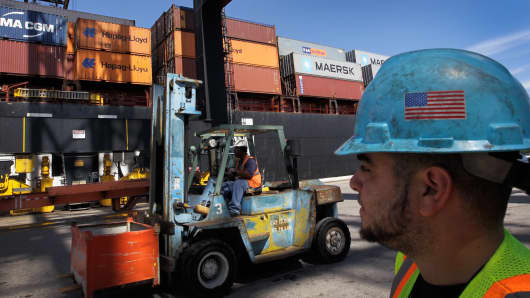After three days of negotiations between shipping companies and dockworkers, Federal Mediation and Conciliation Service Director George H. Cohen said "progress was made" and both parties have agreed that "the negotiations will continue under our auspices."
Cohen said details are not being released on the discussions because of the sensitive nature of the negotiations between the United States Maritime Alliance and the International Longshoremen's Association.
They are trying to come to an agreement before a Feb. 7 strike of 14,500 longshoremen in 14 major East Coast ports, including hubs in New York and New Jersey.
Strike fears were rekindled after Dec. 18, when talks between the dockworkers and the shipping companies broke down.
While the issues of wages remains unresolved, the key point of contention is container royalties, which are payments to union workers based on cargo weight.
The ports in question are major transportation centers that span from Maine to Houston. The price tag of such a strike, according to the National Association of Manufacturers, is a $1 billion per day.
The impact of a potential strike has already been seen in economic data, according to shipping experts. The latest January 2013 import volumes showed a projected 2.3 percent increase over the same period in 2012. Experts say the increase is a sign retailers are concerned about the outcome of the negotiations, so they're increasing inventory to prepare for a shutdown of nearly half of the country's major ports.
Retailers that rely heavily on the shipping industry to transport their products are anxiously awaiting a resolution.
"We are glad to hear that the ILA and USMX have made progress during this week's negotiating session," said Jon Gold, vice president of supply chain and customs policy for the National Retail Federation. "It is critical that the parties remain at the table and continue to work with the federal mediator to reach a new long-term contract before the Feb. 6 contract extension expires. The continuing uncertainty surrounding these negotiations has already had an impact global supply chains as companies must continue to plan for the potential for supply chain disruptions."
The National Retail Federation recently sent letters to both the ILA and USMX urging both sides to come to a definitive agreement not only for the industry's sake but for the sake of the overall U.S. economy.
The New York-New Jersey port is is the largest on the East Coast. According to shipping experts, it handles approximately 10 percent of China imports, 69 percent of Israeli imports and 37 percent of Italian imports. The products from these countries include furniture, plastics, apparel, beverages and chemicals.
In 2011, the New York-New Jersey port handled $208 billion in cargo — the most on the East Coast. Approximately 3,200,000 TEU — a shipping measurement that stands for twenty-foot equivalent units — of containers and 700,000 cars are handled per year. The port generates more than $5 billion in annual tax revenues to state and local governments.


